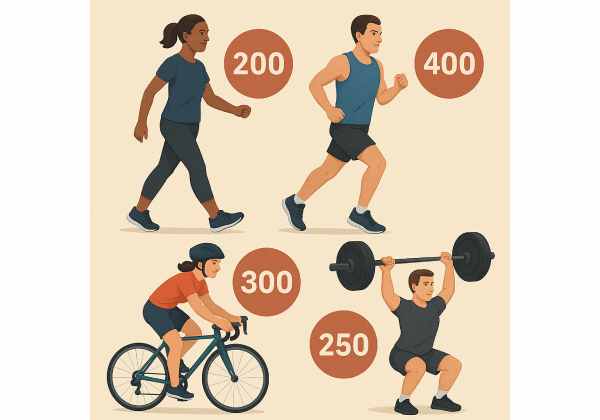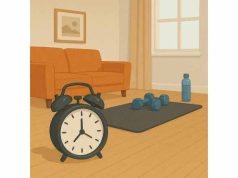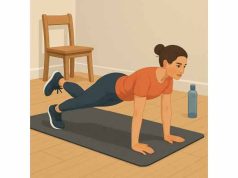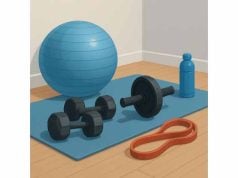
Calorie numbers help you plan, but they’re only estimates—not a verdict on your effort. The most useful approach is to understand what drives energy cost, then apply that knowledge to your favorite activities with reasonable guardrails. In this guide you’ll learn exactly how calorie burn is estimated, realistic ranges for walking, running, cycling, and other popular options, and how to use those numbers to build a weekly plan that actually fits your life. If you’re also organizing strength, cardio, and steps into one routine, see our overview of smart exercise choices for weight loss.
Table of Contents
- How calorie burn works
- Walking: calories by pace
- Running: calories and hills
- Cycling: calories and watts
- Rowing, elliptical, swimming
- Strength and HIIT: what to expect
- Tracking accuracy and planning
- Frequently Asked Questions
How calorie burn works
Calorie burn during activity comes from how much oxygen you use to make energy. Since we don’t all carry a lab around, we estimate energy cost with METs (metabolic equivalents), which translate activity intensity into a multiplier of your resting metabolism. One MET is your resting burn; higher METs mean more oxygen use and more calories.
The basic formula
Calories per minute ≈ MET × 3.5 × body mass (kg) ÷ 200- Body mass matters a lot. Heavier bodies do more work moving the same distance or resisting the same load.
- Intensity drives METs. Faster speeds, hills, resistance, and water drag raise the multiplier.
- Technique and efficiency also affect cost. Skilled cyclists or swimmers often spend fewer calories at a given pace than beginners.
Typical MET ranges (ballpark)
- Walking: ~2.8–3.5 MET (easy, 3.0 mph/4.8 km/h) up to ~5.0–6.0 MET (brisk, 4.0–4.5 mph; incline raises it further).
- Running: ~7.5 MET (jogging) to 9.8+ MET (6.0 mph/9:40 per mile) and higher with speed or hills.
- Cycling: ~4–6 MET (casual 10–12 mph / 16–19 km/h) to 8–10 MET (12–16+ mph / 19–26+ km/h).
- Rowing/Elliptical: ~5–8+ MET depending on pace and resistance.
- Swimming: ~6–10+ MET depending on stroke, pace, and skill.
- Strength training: ~3–6 MET for most sets; circuits and power moves can go higher.
Worked examples (estimates)
- 70 kg (154 lb) at brisk walk (5.0 MET) ≈ 5 × 3.5 × 70 ÷ 200 ≈ 6.1 kcal/min → ~370 kcal/hour.
- 85 kg (187 lb) at steady run (9.8 MET) ≈ 9.8 × 3.5 × 85 ÷ 200 ≈ 14.6 kcal/min → ~875 kcal/hour.
- 70 kg at moderate cycling (8 MET) ≈ 9.8 kcal/min → ~590 kcal/hour.
What the numbers miss
- Afterburn (EPOC): There is some extra burn post-workout, but it’s modest—think tens of calories, not hundreds, for most sessions.
- Compensation: We often move less or eat more after hard exercise. It’s normal; plan for it.
- Device error: Watches and machines can be off by 10–30% (or more). Use them for trends, not truth.
Where this fits in a weight-loss plan
Use calorie estimates to set relative expectations between activities, not to micromanage every snack. Build your week for adherence, recovery, and enjoyment first. For the broader health and nutrition context, skim our hub on safe, sustainable weight loss.
Walking: calories by pace
Walking is the most underestimated fat-loss tool because it’s easy to repeat and easy to scale. Small changes in pace, incline, and total time add up quickly—and because walking is low impact, you’re less likely to “pay” with soreness that steals movement tomorrow.
How pace and terrain change the math
- Easy stroll (≈3 MET, ~3.0 mph/4.8 km/h)
- 70 kg: ~3.7 kcal/min → 220 kcal/hour
- 85 kg: ~4.9 kcal/min → 295 kcal/hour
- Brisk walk (≈5 MET, ~4.0 mph/6.4 km/h)
- 70 kg: ~6.1 kcal/min → 370 kcal/hour
- 85 kg: ~7.5 kcal/min → 450 kcal/hour
- Incline walk (add 3–6% grade) can push effective METs into the 6–8 range without impact, especially on a treadmill.
Steps vs minutes
- Stride length varies, so the same 10,000 steps isn’t the same distance for everyone. As a rough guide, 10,000 steps is ~4–5 miles (6.5–8 km) and ~75–110 minutes for many adults.
- If you like simple targets, average 8,000–12,000 steps/day across the week and adjust food or steps to match your progress. For practical programming, see how 10,000 steps supports fat loss.
Easy ways to raise walking burn
- Add short hills or a treadmill 3–6% incline.
- Take 10–15-minute walks after meals to aid blood sugar control.
- Use a purposeful cadence (~110–125 steps/min) for “brisk but controlled.”
Common mistakes
- Chasing speed over time. Brisk is good, but if it kills your weekly step count, you’ll burn less.
- Ignoring shoes and surfaces. Rotate supportive footwear; vary routes (asphalt, track, treadmill) to spread stress.
- Only walking on weekends. The weekly average drives results—spread movement across days.
Bottom line: Walking’s calorie burn isn’t explosive per minute, but it’s the most recoverable way to raise your total for the week.
Running: calories and hills
Running has a higher energy cost per minute than walking because you’re moving faster and absorbing impact with every stride. That makes it efficient—but it also means careful progression to protect joints and tendons.
Speed, terrain, and impact
- Rule of thumb: Running a mile typically costs ~0.9–1.1 kcal/kg (≈ ~1 kcal/kg/mile).
- 70 kg runner: ~70–77 kcal per mile
- 85 kg runner: ~85–94 kcal per mile
- Pace and grade: Faster speeds and hills raise the METs. Short hill repeats boost intensity without top speed.
Examples (estimates)
- 70 kg at 6.0 mph (9:40/mi; ~9.8 MET) → ~590–600 kcal/hour.
- 85 kg at 7.5 mph (8:00/mi; ~11–12 MET) → 800–900+ kcal/hour depending on efficiency and terrain.
Interval vs steady running
- Intervals (e.g., 2:1 jog\:walk) help beginners tolerate volume while keeping technique clean.
- Steady runs build the aerobic base (Zone 2–3) that makes intervals and life easier.
Joint-friendly progress
- Build with walk-jog intervals (e.g., 1–2 minutes easy jog, 1 minute walk) for 20–30 minutes.
- Increase total jog time each week; keep the walk breaks.
- Add gentle hills or strides only after 4–6 consistent weeks.
If you’re new to running or returning after a layoff, a structured start is worth it. Our beginner plan for running with fewer injuries shows safe weekly jumps and easy strength work that supports your form.
Common mistakes
- Big jumps in weekly distance or speed.
- Ignoring calf/hip strength—both stabilize the run.
- Treating every run like a race. Most should feel conversational.
Bottom line: Running is a potent calorie burner, but the goal is repeatable days, not heroic single sessions.
Cycling: calories and watts
Cycling’s energy cost depends on resistance, cadence, and aerodynamics. Outdoors, wind and grade change everything; indoors, you can pin effort to watts (power), which makes tracking calorie trends easier.
Why power (watts) is handy
Power is work per unit time. If you hold 150 watts for an hour, you produced 540 kJ of mechanical work (150 W × 3600 s). Human bodies aren’t perfectly efficient, so metabolic energy used is higher—roughly 4–5× the mechanical work for most riders. That’s why hour-long sessions at steady watts have fairly predictable calorie ranges for you.
Ballpark METs by effort
- Casual 10–12 mph (16–19 km/h): ~4–6 MET
- Moderate 12–13.9 mph (19–22 km/h): ~8 MET
- Vigorous 14–15.9 mph (22–26 km/h): ~10 MET
- Very vigorous or steep climbs: higher still, depending on power and grade.
Worked examples (estimates)
- 70 kg at moderate effort (~8 MET) → ~590 kcal/hour.
- 85 kg at vigorous effort (~10 MET) → ~750 kcal/hour.
Indoor vs outdoor
- Indoor: easier to control intensity; less coasting; cleaner comparisons across weeks.
- Outdoor: more variability; descents lower average power but climbs can spike cost.
Comfort and position affect cost
- Low cadence “grinding” can feel harder with similar energy use; experiment.
- Aerodynamic position reduces drag at speed, lowering required power (and calories) for a given pace. That’s useful for speed goals; for calorie goals, just keep the power target honest.
If you want a structured mix of indoor intervals and outdoor base rides, use our practical cycling plan for fat loss with clear progressions.
Bottom line: Use time × average power (indoors) or steady perceived effort (outdoors) to keep sessions repeatable and calorie trends sensible.
Rowing, elliptical, swimming
These cardio options are joint-friendly ways to raise weekly energy use. They also train large muscle groups together, which helps you accumulate meaningful work without impact.
Rowing ergometer
- Why it burns: Legs drive, hips and back transmit, arms finish—big muscle coordination means high demand.
- Estimates: ~7 MET (moderate) to 8.5+ MET (vigorous).
- Technique beats flailing: Keep strokes 22–28 spm, push with legs, then hinge, then pull; reverse to return. For cleaner form and interval ideas, see our rower technique guide.
Elliptical
- Why it works: Whole-body cyclic motion with adjustable resistance and low joint load.
- Estimates: ~5–8 MET depending on stride length, resistance, and cadence.
- Tip: Stand tall, avoid leaning on handles; let resistance—not momentum—set the challenge.
Swimming
- Why it burns: Water drag is unforgiving; technique and breathing control matter.
- Estimates: ~6 MET (steady lap swim) to 9–10+ MET (vigorous sets, faster strokes).
- Skill effect: Skilled swimmers often burn less at a given pace due to efficiency—use sets and interval clocks to keep intensity honest.
Who benefits most from these modalities
- Anyone managing knee, hip, or back irritability from impact.
- Lifters who want conditioning without sore joints.
- Folks who enjoy technique-driven training and clear, repeatable intervals.
Simple interval ideas (10–20 minutes of work inside a 20–30 minute session)
- Row: 40s hard / 20s easy × 10 at 24–28 spm.
- Elliptical: 50s hard / 40s easy × 12, maintain full stride.
- Swim: 50 m strong / 25 m easy × 12 (or 25s on / 15s off × 16 with a tempo trainer).
Strength and HIIT: what to expect
Strength and high-intensity intervals won’t always “win” the calorie race per minute, but they are crucial for body composition and time efficiency.
Strength training (sets and reps)
- Typical energy cost: ~3–6 MET across the hour, with peaks during sets and dips between.
- Why it matters: Protects muscle in a calorie deficit, supports posture and joint health, and keeps your 24-hour burn higher than cardio-only plans.
Circuit strength and metabolic finishers
- Turning strength into time-boxed intervals (e.g., 40s work / 20s rest) raises density.
- Finisher ideas (6–8 minutes): kettlebell/dumbbell swings; step-overs + shadow boxing; bike or rower 30/30 repeats.
HIIT (hard but repeatable)
- Why it’s efficient: Accumulates time near your personal “high” zone without holding it continuously.
- Energy cost: Often 150–350+ kcal for a focused 20-minute session, depending on body size and modality.
- Recovery matters: EPOC exists but is smaller than marketing suggests. Don’t count on a huge afterburn.
Curious how intervals compare with steady cardio across a week? Our concise guide to HIIT vs steady-state cardio explains benefits and when to use each.
Programming that works
- 2–3 strength days (full-body).
- 1–2 HIIT days if you enjoy them, separated by easier days.
- Daily steps for background burn and appetite control.
Bottom line: Strength preserves the “engine.” HIIT condenses conditioning. Together with steps, they support a reliable deficit without frying your recovery.
Tracking accuracy and planning
You don’t need perfect numbers—just consistent methods. Use the same tools and conditions so trends mean something.
Make your numbers useful
- Choose one primary metric for each modality.
- Walk: time at a “brisk but talkable” pace or average steps.
- Run: distance/time or average pace on a familiar route.
- Bike: average power (watts) or heart-rate zone.
- Rower/Elliptical/Swim: distance/time or interval structure.
- Log two or three variables max (e.g., time + RPE + steps). More data isn’t better if it stops you training.
- Compare like to like. Similar routes, times of day, shoes, and weather improve comparability.
Wearables and machines
- Treat calorie readouts as estimates with bias. Many devices over- or under-count by double digits.
- If your watch supports custom heart-rate zones and updated body mass, keep them current to improve estimates.
- Treadmills and bikes often report work (distance, pace, watts) more consistently than calories.
EPOC and “afterburn” reality check
- Afterburn exists but is generally modest relative to the session. Focus on total weekly work and nutrition rather than banking on post-workout burn.
Safety and who should modify
- If you have cardiovascular, metabolic, or orthopedic conditions—or take medications that affect heart rate or balance—ask your clinician for parameters. Use effort-based cues (talk test, RPE) more than formulas when meds alter HR response.
- Choose low-impact modalities (bike, rower, elliptical, pool walking) if joints complain; progress gradually.
How to use calorie numbers without obsession
- Plan with ranges, not single numbers. Example: “Brisk walk ~300–400 kcal/hour; run ~600–900 kcal/hour.”
- Adjust one lever at a time when progress stalls: slightly lower intake, add one short session, or nudge steps.
- Judge success by weekly averages (weight, steps), clothing fit, and performance, not by daily fluctuations.
Frequently Asked Questions
How accurate are calorie estimates from watches and machines?
They’re educated guesses. Error can reach 10–30% or more. Use the same device and conditions so the bias is consistent, then watch trends alongside weekly weight, steps, and performance. Numbers help with planning, but behaviors and averages tell the real story.
What burns more: walking or running the same distance?
Running generally burns more per minute because it’s faster and more intense. For the same distance, totals are closer; body mass and efficiency matter. Choose the option you’ll repeat without injury. Brisk walking with hills or incline can narrow the gap.
How many calories does a 30-minute workout burn?
It depends on body size and intensity. Rough ranges: easy walk ~110–200 kcal, brisk walk ~180–300, steady run ~300–450+, moderate cycling ~250–350+, vigorous row/elliptical ~250–400+. Treat these as planning ranges, not precise receipts.
Does HIIT burn more calories than steady cardio?
Per minute, HIIT is often higher, but totals across a week depend on recovery and adherence. Many people get better long-term results by mixing intensities: a couple of short interval sessions plus steady, conversational cardio and daily steps.
Do strength workouts burn fewer calories than cardio?
Usually per minute, yes. But strength protects muscle, which helps maintain your 24-hour burn and shape. Circuits and short finishers raise the session’s energy cost while keeping the benefits of resistance training.
How can I increase calories burned without wrecking my joints?
Raise time at easy/moderate effort, add incline walking or low-impact intervals, and keep steps high. Mix in cycling, rowing, or elliptical. Progress slowly, rotate footwear, and prioritize sleep and protein for recovery.
References
- 2024 Adult Compendium of Physical Activities: A third update of the energy costs of human activities 2024 (Compendium Update)
- Accuracy and Acceptability of Wrist-Wearable Activity-Tracking Devices: Systematic Review of the Literature 2022 (Systematic Review)
- Association of Daily Step Patterns With Mortality in US Adults 2023
- Acute interval running induces greater excess post-exercise oxygen consumption and lipid oxidation than isocaloric continuous running in men with obesity 2024 (RCT)
- A Comparison of Methodological Approaches to Measuring Cycling Mechanical Efficiency 2019
Medical Disclaimer
This article shares general fitness information and energy-use estimates. It is not a substitute for personalized medical advice. Consult your healthcare professional before starting or changing an exercise or weight-loss plan, especially if you have medical conditions, are pregnant or postpartum, or take medications that affect heart rate, blood pressure, or balance.
If this guide helped you, consider sharing it with a friend. You’re welcome to follow us on Facebook or X for practical templates and calm, evidence-based coaching tips.










